Reasons for East Siberia Winter Snow Water Equivalent Increase in the Recent Decades
Abstract
:1. Introduction
2. Data and Methods
2.1. Study Area
2.2. Datasets
2.3. Methods
3. Results
3.1. Feature and Sources of the SWE Increase
3.2. Reasons for the SWE Increase
3.3. Future Changes in CMIP6 Model Simulations
4. Discussion and Conclusions
Author Contributions
Funding
Data Availability Statement
Conflicts of Interest
Appendix A
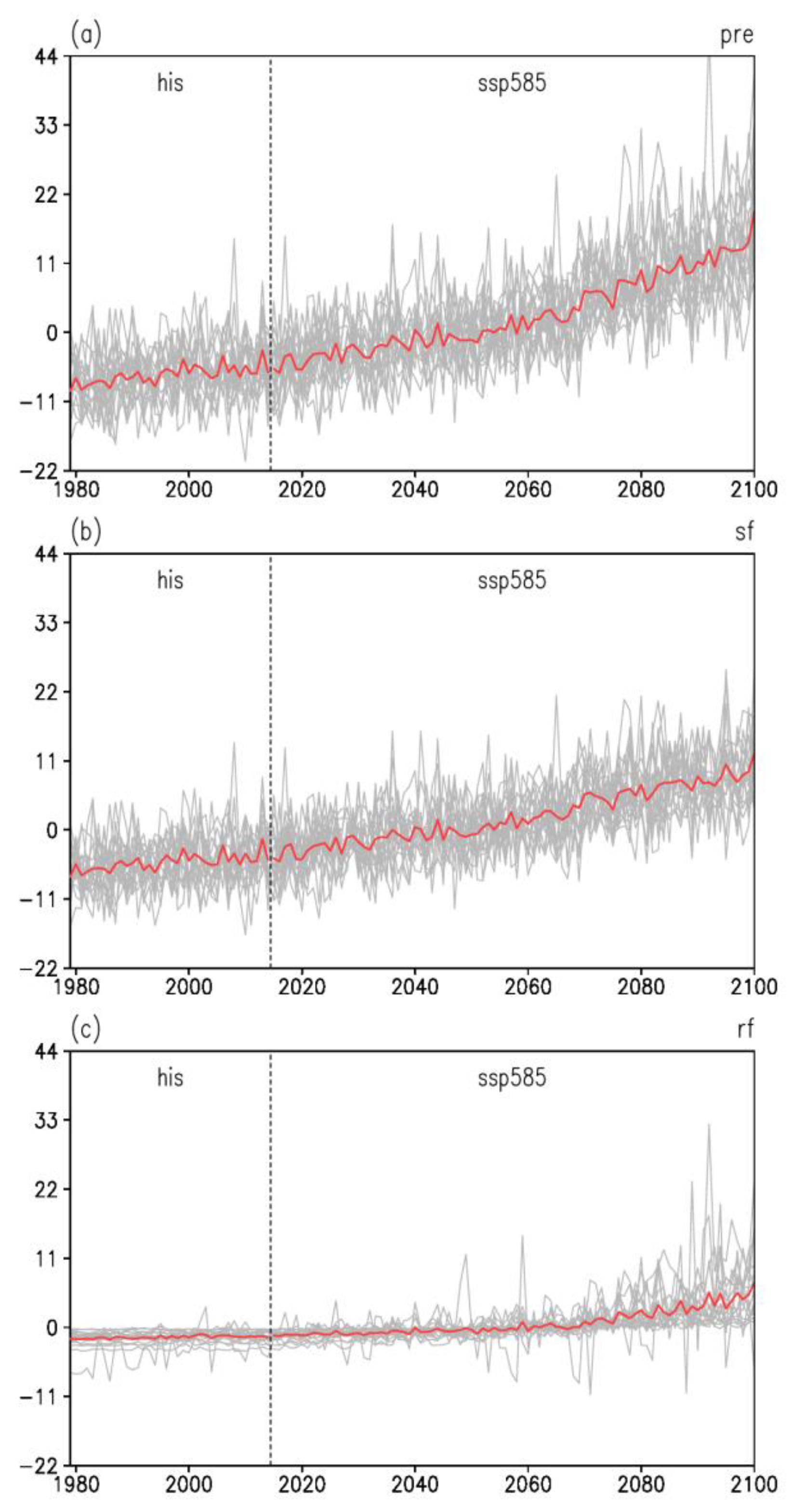
References
- Cohen, J.; Rind, D. The effect of snow cover on the climate. J. Clim. 1991, 4, 689–706. [Google Scholar] [CrossRef]
- You, Q.; Wu, T.; Shen, L.; Pepin, N.; Zhang, L.; Jiang, Z.; AghaKouchak, A. Review of snow cover variation over the Tibetan Plateau and its influence on the broad climate system. Earth-Sci. Rev. 2020, 201, 103043. [Google Scholar] [CrossRef]
- Suriano, Z.J.; Leathers, D.J. Great lakes basin snow-cover ablation and synoptic-scale circulation. J. Appl. Meteorol. Climatol. 2018, 57, 1497–1510. [Google Scholar] [CrossRef]
- Song, L.; Wu, R. Intraseasonal snow cover variations over western Siberia and associated atmospheric processes. J. Geophys. Res. Atmos. 2019, 124, 8994–9010. [Google Scholar] [CrossRef]
- Li, W.; Guo, W.; Qiu, B.; Xue, Y.; Hsu, P.C.; Wei, J. Influence of Tibetan Plateau snow cover on East Asian atmospheric circulation at medium-range time scales. Nat. Commun. 2018, 9, 4243. [Google Scholar] [CrossRef] [Green Version]
- Wang, Z.; Wu, R.; Duan, A.; Qu, X. Influence of eastern Tibetan Plateau spring snow cover on North American air temperature and its interdecadal change. J. Clim. 2020, 33, 5123–5139. [Google Scholar] [CrossRef] [Green Version]
- Jia, X.; Zhang, C.; Wu, R.; Qian, Q. Influence of Tibetan Plateau autumn snow cover on interannual variations in spring precipitation over southern China. Clim. Dyn. 2021, 56, 767–782. [Google Scholar] [CrossRef]
- Zhang, T. Influence of the seasonal snow cover on the ground thermal regime: An overview. Rev. Geophys. 2005, 43, 1–23. [Google Scholar] [CrossRef]
- Déry, S.J.; Brown, R.D. Recent Northern Hemisphere snow cover extent trends and implications for the snow-albedo feedback. Geophys. Res. Lett. 2007, 34, 1–6. [Google Scholar] [CrossRef]
- Tsai, Y.L.S.; Dietz, A.; Oppelt, N.; Kuenzer, C. Remote sensing of snow cover using spaceborne SAR: A review. Remote Sens. 2019, 11, 1456. [Google Scholar] [CrossRef]
- Barnett, T.P.; Adam, J.C.; Lettenmaier, D.P. Potential impacts of a warming climate on water availability in snow-dominated regions. Nature 2005, 438, 303–309. [Google Scholar] [CrossRef] [PubMed]
- Immerzeel, W.W.; Droogers, P.; De Jong, S.M.; Bierkens, M.F.P. Large-scale monitoring of snow cover and runoff simulation in Himalayan river basins using remote sensing. Remote Sens. Environ. 2009, 113, 40–49. [Google Scholar] [CrossRef]
- Dietz, A.J.; Conrad, C.; Kuenzer, C.; Gesell, G.; Dech, S. Identifying changing snow cover characteristics in Central Asia between 1986 and 2014 from remote sensing data. Remote Sens. 2014, 6, 12752–12775. [Google Scholar] [CrossRef] [Green Version]
- Yang, D.; Robinson, D.; Zhao, Y.; Estilow, T.; Ye, B. Streamflow response to seasonal snow cover extent changes in large Siberian watersheds. J. Geophys. Res. Atmos. 2003, 108, D18. [Google Scholar] [CrossRef]
- Galvagno, M.; Wohlfahrt, G.; Cremonese, E.; Rossini, M.; Colombo, R.; Filippa, G.; Migliavacca, M. Phenology and carbon dioxide source/sink strength of a subalpine grassland in response to an exceptionally short snow season. Environ. Res. Lett. 2013, 8, 025008. [Google Scholar] [CrossRef]
- Musselman, K.N.; Addor, N.; Vano, J.A.; Molotch, N.P. Winter melt trends portend widespread declines in snow water resources. Nat. Clim. Chang. 2021, 11, 418–424. [Google Scholar] [CrossRef]
- Brown, R.D.; Robinson, D.A. Northern Hemisphere spring snow cover variability and change over 1922–2010 including an assessment of uncertainty. Cryosphere 2011, 5, 219–229. [Google Scholar] [CrossRef] [Green Version]
- McCabe, G.J.; Wolock, D.M. Long-term variability in Northern Hemisphere snow cover and associations with warmer winters. Clim. Chang. 2010, 99, 141–153. [Google Scholar] [CrossRef]
- Wang, Z.; Wu, R.; Huang, G. Low-frequency snow changes over the Tibetan Plateau. Int. J. Climatol. 2018, 38, 949–963. [Google Scholar] [CrossRef]
- Mudryk, L.R.; Derksen, C.; Kushner, P.J.; Brown, R. Characterization of Northern Hemisphere snow water equivalent datasets, 1981–2010. J. Clim. 2015, 28, 8037–8051. [Google Scholar] [CrossRef]
- Kunkel, K.E.; Robinson, D.A.; Champion, S.; Yin, X.; Estilow, T.; Frankson, R.M. Trends and extremes in Northern Hemisphere snow characteristics. Curr. Clim. Chang. Rep. 2016, 2, 65–73. [Google Scholar] [CrossRef] [Green Version]
- Hernández-Henríquez, M.A.; Déry, S.J.; Derksen, C. Polar amplification and elevation-dependence in trends of Northern Hemisphere snow cover extent, 1971–2014. Environ. Res. Lett. 2015, 10, 044010. [Google Scholar] [CrossRef]
- Wu, R.; Chen, S. Regional change in snow water equivalent–surface air temperature relationship over Eurasia during boreal spring. Clim. Dyn. 2016, 47, 2425–2442. [Google Scholar] [CrossRef]
- Pulliainen, J.; Luojus, K.; Derksen, C.; Mudryk, L.; Lemmetyinen, J.; Salminen, M.; Norberg, J. Patterns and trends of Northern Hemisphere snow mass from 1980 to 2018. Nature 2020, 581, 294–298. [Google Scholar] [CrossRef]
- Sazonova, T.S.; Romanovsky, V.E.; Walsh, J.E.; Sergueev, D.O. Permafrost dynamics in the 20th and 21st centuries along the East Siberian transect. J. Geophys. Res. Atmos. 2004, 109, D1. [Google Scholar] [CrossRef]
- Bintanja, R.; Andry, O. Towards a rain-dominated Arctic. Nat. Clim. Chang. 2017, 7, 263–267. [Google Scholar] [CrossRef]
- Box, J.E.; Colgan, W.T.; Christensen, T.R.; Schmidt, N.M.; Lund, M.; Parmentier, F.J.W.; Olsen, M.S. Key indicators of Arctic climate change: 1971–2017. Environ. Res. Lett. 2019, 14, 045010. [Google Scholar] [CrossRef]
- Masson-Delmotte, V.; Zhai, P.; Pirani, A.; Connors, S.L.; Péan, C.; Berger, S.; Zhou, B. Climate Change 2021: The Physical Science Basis; Contribution of Working Group I to the Sixth Assessment Report of the Intergovernmental Panel on Climate Change; Cambridge University Press: Cambridge, UK, 2021; p. 2. [Google Scholar]
- Luojus, K.; Pulliainen, J.; Takala, M.; Lemmetyinen, J.; Mortimer, C.; Derksen, C.; Venäläinen, P. GlobSnow v3. 0 Northern Hemisphere snow water equivalent dataset. Sci. Data 2021, 8, 163. [Google Scholar] [CrossRef]
- Hill, C.; DeLuca, C.; Suarez, M.; Da Silva, A. The architecture of the earth system modeling framework. Comput. Sci. Eng. 2004, 6, 18–28. [Google Scholar] [CrossRef]
- Hersbach, H.; Bell, B.; Berrisford, P.; Hirahara, S.; Horányi, A.; Muñoz-Sabater, J.; Thépaut, J.N. The ERA5 global reanalysis. Q. J. R. Meteorol. Soc. 2020, 146, 1999–2049. [Google Scholar] [CrossRef]
- Barrett, A.P.; Stroeve, J.C.; Serreze, M.C. Arctic Ocean precipitation from atmospheric reanalyses and comparisons with North Pole drifting station records. J. Geophys. Res. Oceans 2020, 125, e2019JC015415. [Google Scholar] [CrossRef]
- Graham, R.M.; Hudson, S.R.; Maturilli, M. Improved performance of ERA5 in Arctic gateway relative to four global atmospheric reanalyses. Geophys. Res. Lett. 2019, 46, 6138–6147. [Google Scholar] [CrossRef] [Green Version]
- Cucchi, M.; Weedon, G.P.; Amici, A.; Bellouin, N.; Lange, S.; Müller Schmied, H.; Hersbach, H.; Cagnazzo, C.; Buontempo, C. Near Surface Meteorological Variables from 1979 to 2019 Derived from Bias-Corrected Reanalysis, Version 2.1; Copernicus Climate Change Service (C3S) Climate Data Store (CDS): Reading, UK, 2022. [Google Scholar]
- Cucchi, M.; Weedon, G.P.; Amici, A.; Bellouin, N.; Lange, S.; Müller Schmied, H.; Buontempo, C. WFDE5: Bias-adjusted ERA5 reanalysis data for impact studies. Earth Syst. Sci. Data 2020, 12, 2097–2120. [Google Scholar]
- Harris, I.P.D.J.; Jones, P.D.; Osborn, T.J.; Lister, D.H. Updated high-resolution grids of monthly climatic observations–the CRU TS3. 10 Dataset. Int. J. Climatol. 2014, 34, 623–642. [Google Scholar] [CrossRef] [Green Version]
- Eyring, V.; Bony, S.; Meehl, G.A.; Senior, C.A.; Stevens, B.; Stouffer, R.J.; Taylor, K.E. Overview of the Coupled Model Intercomparison Project Phase 6 (CMIP6) experimental design and organization. Geosci. Model Dev. 2016, 9, 1937–1958. [Google Scholar] [CrossRef] [Green Version]
- Chou, C.; Neelin, J.D.; Chen, C.A.; Tu, J.Y. Evaluating the “rich-get-richer” mechanism in tropical precipitation change under global warming. J. Clim. 2009, 22, 1982–2005. [Google Scholar] [CrossRef]
- Chou, C.; Lan, C.W. Changes in the annual range of precipitation under global warming. J. Clim. 2012, 25, 222–235. [Google Scholar] [CrossRef] [Green Version]
- Huang, P.; Xie, S.P.; Hu, K.; Huang, G.; Huang, R. Patterns of the seasonal response of tropical rainfall to global warming. Nat. Geosci. 2013, 6, 357–361. [Google Scholar] [CrossRef]
- Zhou, S.; Huang, G.; Huang, P. Changes in the East Asian summer monsoon rainfall under global warming: Moisture budget decompositions and the sources of uncertainty. Clim. Dyn. 2018, 51, 1363–1373. [Google Scholar] [CrossRef]
- Mann, H.B. Nonparametric tests against trend. Econometrika 1945, 13, 245–259. [Google Scholar] [CrossRef]
- Hamed, K.H. Trend detection in hydrologic data: The Mann–Kendall trend test under the scaling hypothesis. J. Hydrol. 2008, 349, 350–363. [Google Scholar] [CrossRef]
- Mudryk, L.; Santolaria-Otín, M.; Krinner, G.; Ménégoz, M.; Derksen, C.; Brutel-Vuilmet, C.; Essery, R. Historical Northern Hemisphere snow cover trends and projected changes in the CMIP6 multi-model ensemble. Cryosphere 2020, 14, 2495–2514. [Google Scholar] [CrossRef]
- Henderson, G.R.; Peings, Y.; Furtado, J.C.; Kushner, P.J. Snow–atmosphere coupling in the Northern Hemisphere. Nat. Clim. Chang. 2018, 8, 954–963. [Google Scholar] [CrossRef]
- Thompson, D.W.; Wallace, J.M. The Arctic Oscillation signature in the wintertime geopotential height and temperature fields. Geophys. Res. Lett. 1998, 25, 1297–1300. [Google Scholar] [CrossRef] [Green Version]
- Orsolini, Y.J.; Kvamstø, N.G. Role of Eurasian snow cover in wintertime circulation: Decadal simulations forced with satellite observations. J. Geophys. Res. Atmos. 2009, 114, D19. [Google Scholar] [CrossRef]
- Tei, S.; Morozumi, T.; Nagai, S.; Takano, S.; Sugimoto, A.; Shingubara, R.; Maximov, T. An extreme flood caused by a heavy snowfall over the Indigirka River basin in Northeastern Siberia. Hydrol. Process. 2020, 34, 522–537. [Google Scholar] [CrossRef]
- Zhu, X.; Lee, S.Y.; Wen, X.; Wei, Z.; Ji, Z.; Zheng, Z.; Dong, W. Historical evolution and future trend of Northern Hemisphere snow cover in CMIP5 and CMIP6 models. Environ. Res. Lett. 2021, 16, 065013. [Google Scholar] [CrossRef]
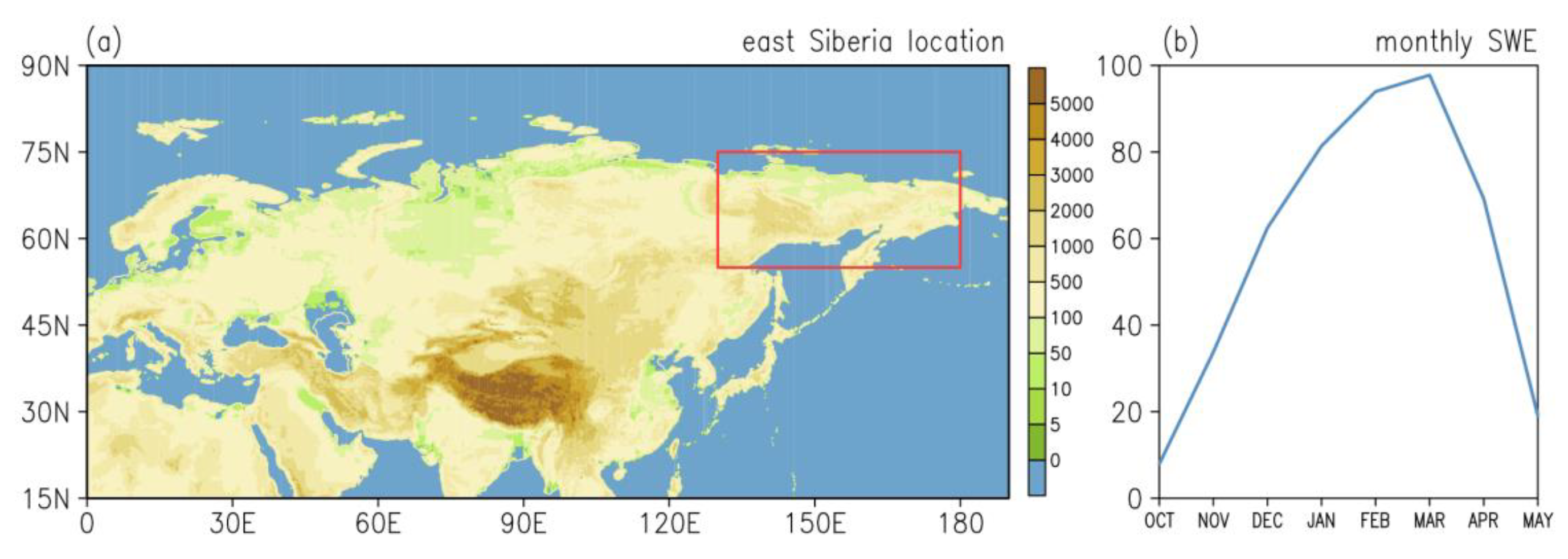
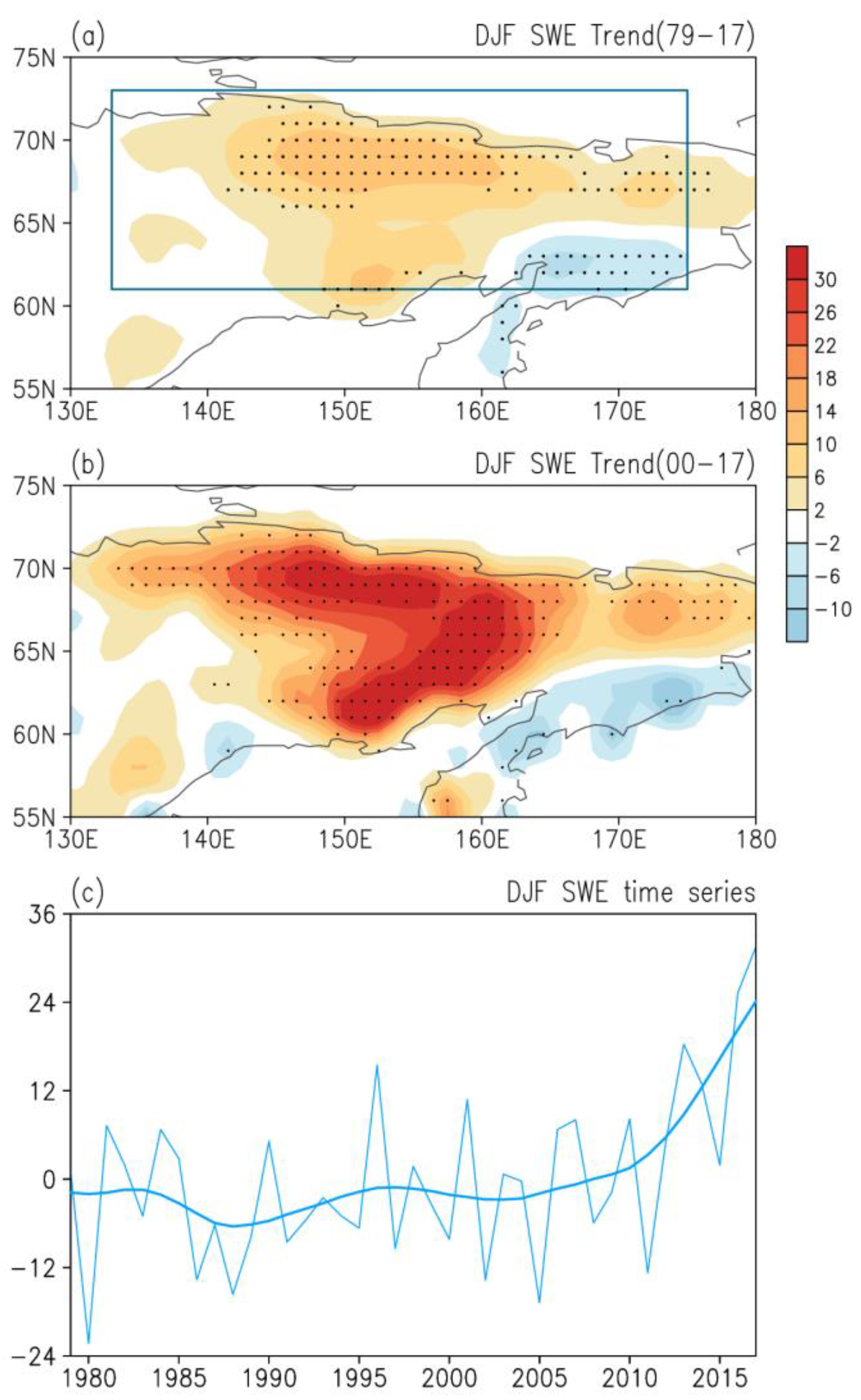
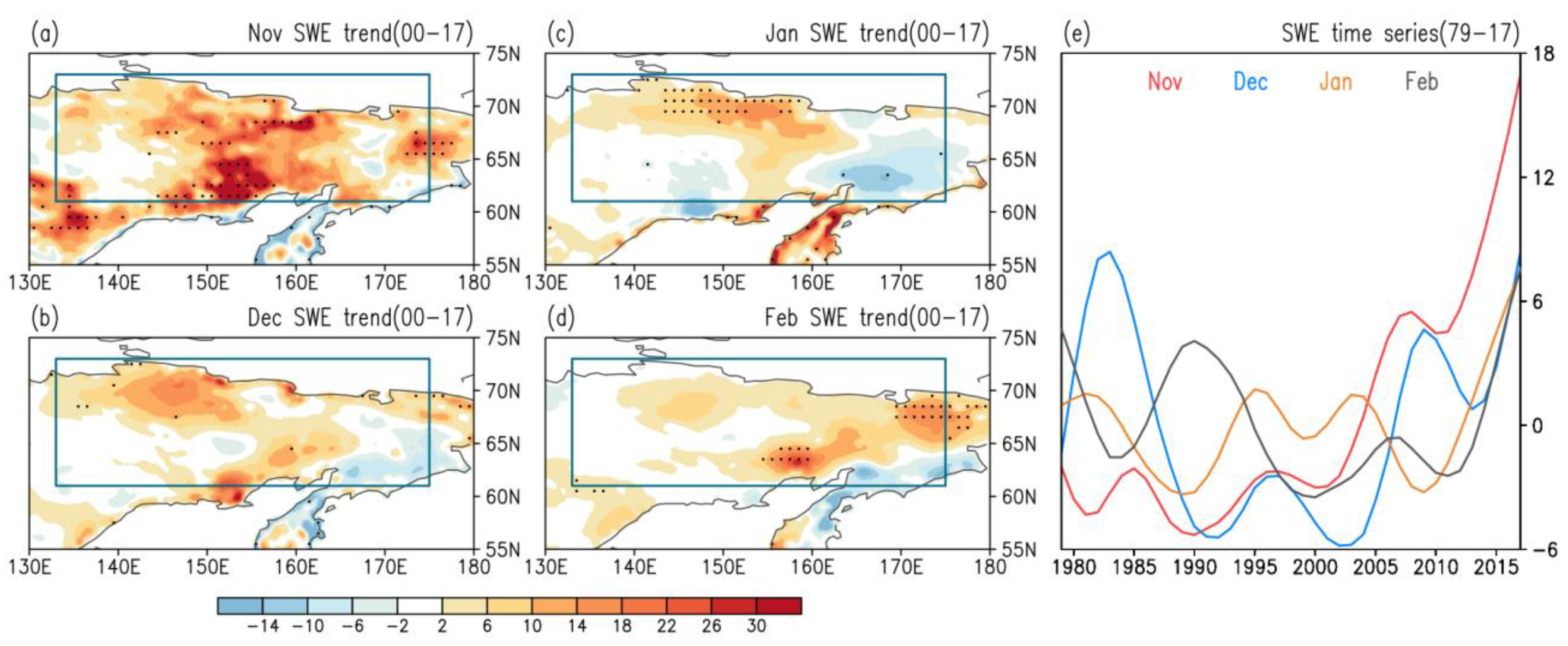
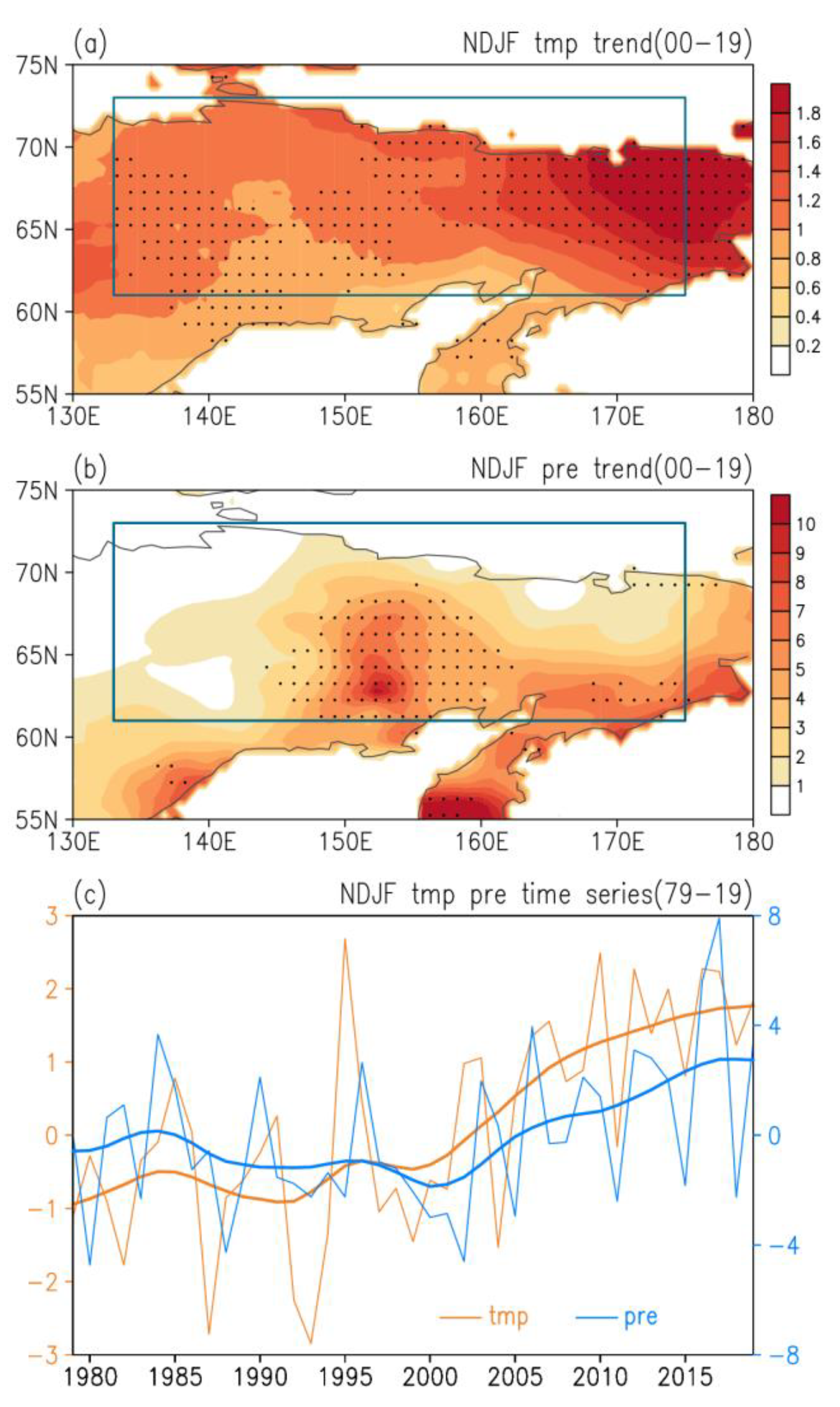


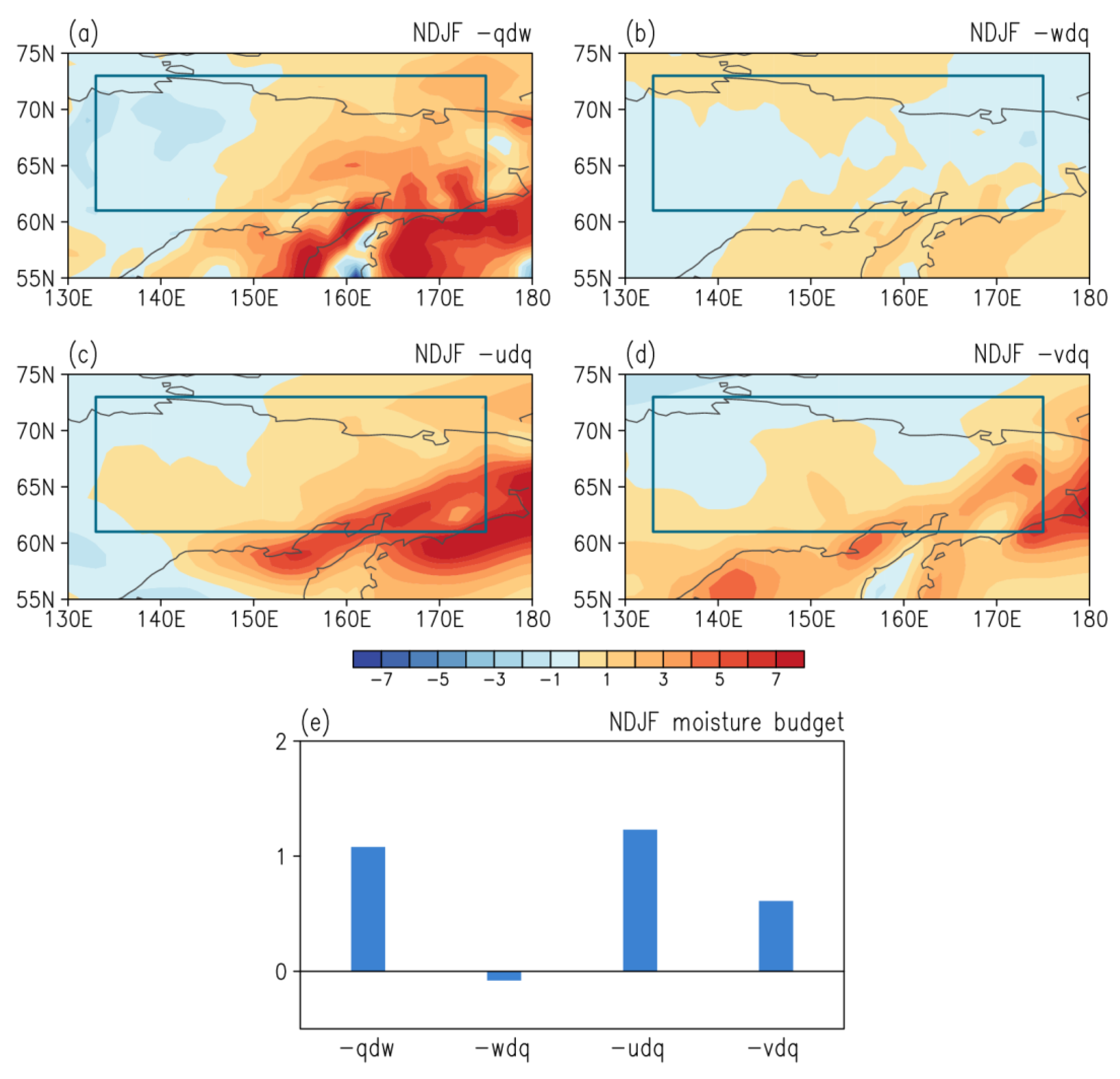
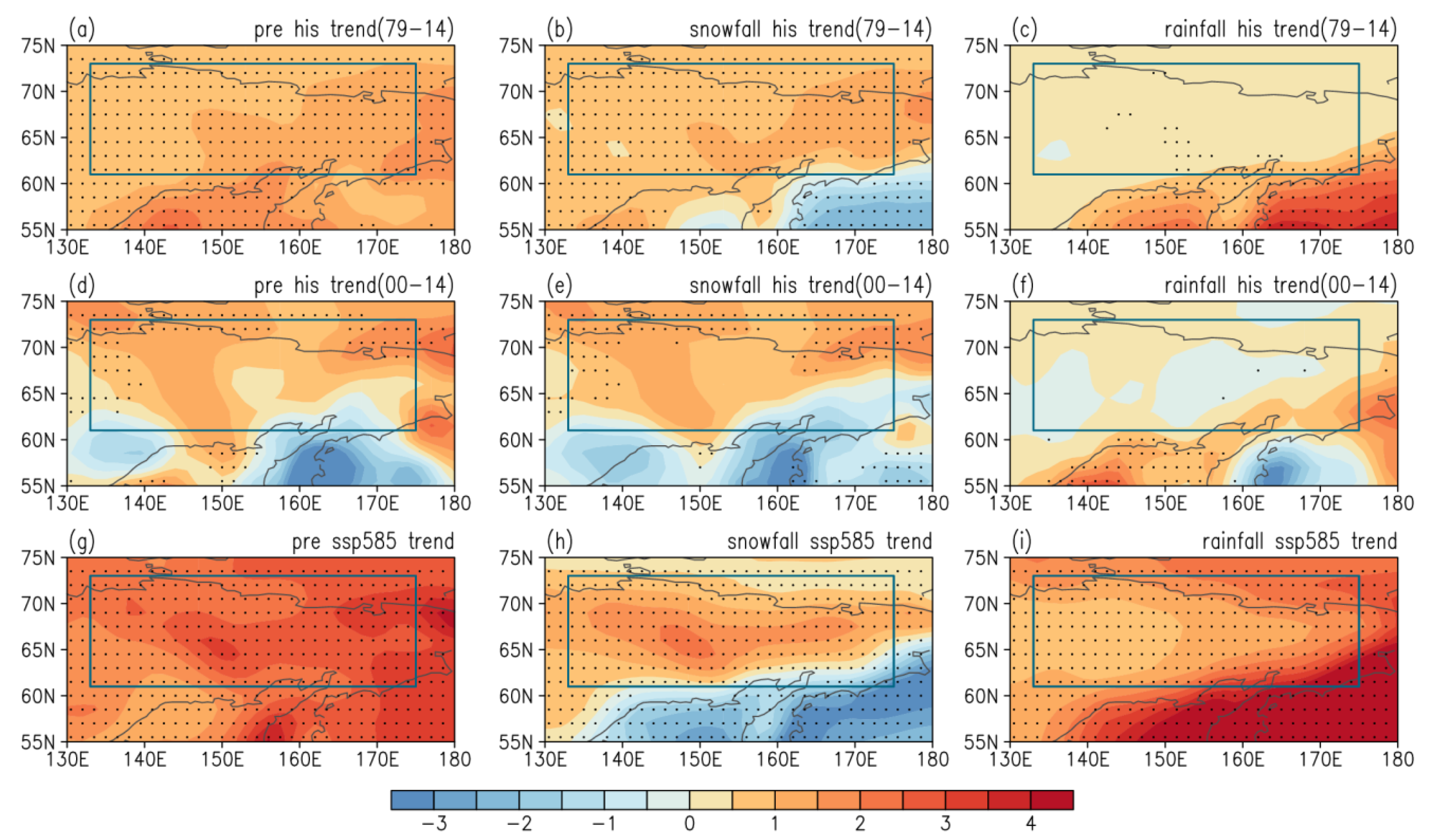
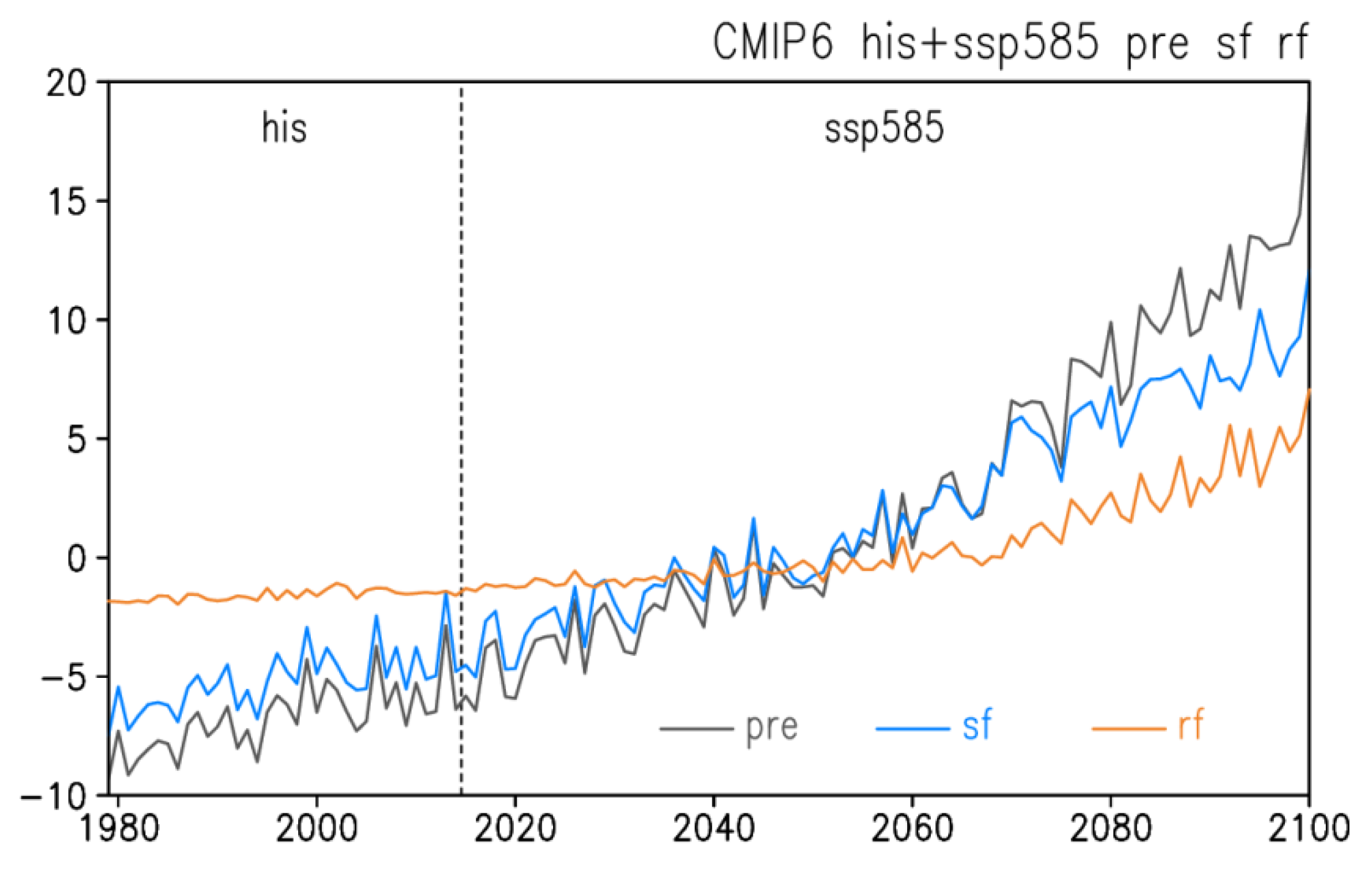
| Dataset | Spatial Resolution | Time Resolution | Access Site |
|---|---|---|---|
| GlobSnow v3.0 | 0.25° × 0.25° 25 km × 25 km | Daily Monthly | https://globsnow.info/swe/archive_v3.0/ accessed on 3 August 2021 |
| ERA5 | 0.5° × 0.5° | Monthly | https://ecmwf.int/en/forecasts/dataset/ecmwf-reanalysis-v5 accessed on 2 March 2022 |
| WFDE5 v2.1 | 0.5° × 0.5° | Hourly | https://cds.climate.copernicus.eu/cdsapp#!/dataset/derived-near-surface-meteorological-variables accessed on 8 July 2022 |
| CRU ts4.06 | 0.5° × 0.5° | Monthly | https://crudata.uea.ac.uk/cru/data/hrg/cru_ts_4.06/ accessed on 6 March 2022 |
| CMIP6 Models | Resolution (Lon × Lat) |
|---|---|
| ACCESS-CM2 | 1.875° × 1.25° |
| BCC-CSM2-MR | 1.125° × 1.125° |
| CanESM5-CanOE | 2.8125° × 2.8125° |
| CNRM-CM6-1-HR | 0.5° × 0.5° |
| CNRM-CM6-1 | 1.40625° × 1.40625° |
| CNRM-ESM2-1 | 1.40625° × 1.40625° |
| FGOALS-f3-L | 1.25° × 1.0° |
| GFDL-ESM4 | 1.25° × 1.0° |
| INM-CM4-8 | 2.0° × 1.5° |
| INM-CM5-0 | 2.0° × 1.5° |
| IPSL-CM6A-LR | 2.5° × 1.268° |
| MCM-UA-1-0 | 3.75 × 2.25° |
| MIROC-ES2L | 2.8125° × 2.8125° |
| MIROC6 | 1.40625° × 1.40625° |
| MPI-ESM1-2-LR | 1.875° × 1.875° |
| MRI-ESM2-0 | 1.125° × 1.125° |
| NorESM2-MM | 1.25° × 0.9375° |
| UKESM1-0-LL | 1.875° × 1.25° |
Disclaimer/Publisher’s Note: The statements, opinions and data contained in all publications are solely those of the individual author(s) and contributor(s) and not of MDPI and/or the editor(s). MDPI and/or the editor(s) disclaim responsibility for any injury to people or property resulting from any ideas, methods, instructions or products referred to in the content. |
© 2022 by the authors. Licensee MDPI, Basel, Switzerland. This article is an open access article distributed under the terms and conditions of the Creative Commons Attribution (CC BY) license (https://creativecommons.org/licenses/by/4.0/).
Share and Cite
Wang, Z.; Wu, R.; Chen, Z.; Huang, G.; Yang, X. Reasons for East Siberia Winter Snow Water Equivalent Increase in the Recent Decades. Remote Sens. 2023, 15, 134. https://doi.org/10.3390/rs15010134
Wang Z, Wu R, Chen Z, Huang G, Yang X. Reasons for East Siberia Winter Snow Water Equivalent Increase in the Recent Decades. Remote Sensing. 2023; 15(1):134. https://doi.org/10.3390/rs15010134
Chicago/Turabian StyleWang, Zhibiao, Renguang Wu, Zhang Chen, Gang Huang, and Xianke Yang. 2023. "Reasons for East Siberia Winter Snow Water Equivalent Increase in the Recent Decades" Remote Sensing 15, no. 1: 134. https://doi.org/10.3390/rs15010134
APA StyleWang, Z., Wu, R., Chen, Z., Huang, G., & Yang, X. (2023). Reasons for East Siberia Winter Snow Water Equivalent Increase in the Recent Decades. Remote Sensing, 15(1), 134. https://doi.org/10.3390/rs15010134






